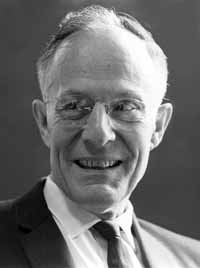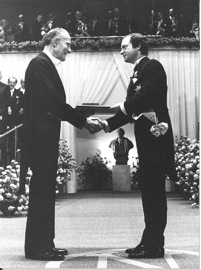Theodore Schultz facts for kids
Quick facts for kids
Theodore Schultz
|
|
|---|---|
 |
|
| Born | April 30, 1902 Arlington, South Dakota, United States
|
| Died | 26 February 1998 (aged 95) Evanston, Illinois, United States
|
| Nationality | American |
| Institution | |
| Field | Agricultural economics |
| School or tradition |
Chicago school of economics |
| Alma mater | |
| Awards | Nobel Memorial Prize in Economic Sciences (1979) |
| Information at IDEAS / RePEc | |
Theodore William Schultz (born April 30, 1902 – died February 26, 1998) was an American economist. He was also the head of the Economics Department at the University of Chicago. Schultz became famous after winning the 1979 Nobel Memorial Prize in Economic Sciences.
Contents
Early Life and Education
Theodore William Schultz was born on April 30, 1902. He grew up on a large farm in Badger, South Dakota. When he was in eighth grade, his father took him out of school. His father believed that too much education would make him not want to work on the farm. So, Theodore did not go to high school.
Later, he joined a special three-year program at the Agriculture College at South Dakota State. This program met for four months each winter. People saw that he was a very smart student. He then went on to earn a bachelor's degree in agriculture and economics in 1928. In 1959, he also received an honorary science degree from the college. After graduating in 1927, he went to the University of Wisconsin–Madison. He earned his doctorate degree in Agricultural Economics in 1930.
Academic Career
Schultz taught at Iowa State College from 1930 to 1943. He then became the head of economics at the University of Chicago from 1946 to 1961. In 1960, he became the president of the American Economic Association. He retired in 1970 but stayed active at the University of Chicago until he was in his 90s.
After moving to Chicago, Schultz invited his former student, D. Gale Johnson, to join the department. Their work on farm and agricultural economics was very important. It helped bring money from the Rockefeller Foundation to the agricultural economics program. Many students and teachers worked with them in the 1940s and 1950s. In 1979, Schultz won the Nobel Prize in Economics. This was for his ideas on human capital theory and economic development.
Big Ideas in Economics
Human Capital Theory

When Schultz was leading the economics department in Chicago, he studied why Germany and Japan recovered so quickly after World War II. These countries had been badly damaged by the war. He wondered why the United Kingdom was still having food shortages long after the war. He found that the fast recovery was because of their healthy and well-educated populations. He believed that education makes people more productive. Good health care helps keep these educated people working and producing.
One of his main ideas was called Human Capital Theory. He developed this idea with other economists like Gary Becker. Schultz explained this theory in his book, Investment in Human Capital. He said that knowledge and skills are a type of capital, like money or machines. Investing in human capital, through education and health, helps economies grow. It also helps workers earn more money. Some economists did not like the idea of calling humans "capital" because of the history of slavery. But Schultz argued that his theory was about helping people invest in themselves. He encouraged people to improve their health, move for better jobs, and get on-the-job training. He especially focused on getting a better education to become more productive. He believed these steps would open up many more chances for people to improve their lives.
Schultz's work also inspired efforts in international development in the 1980s. It led to investments in education and training by groups like the International Monetary Fund and the World Bank. Schultz traveled to poor farming nations in Europe. He talked to farmers and leaders to understand their problems. He saw that sending food or money as aid often did not help much. Sometimes, it even hurt local farmers. This was because they could not compete with the free aid.
He thought that if the U.S. helped educate these farmers and gave them new technology, they would become more stable. They would be more productive and able to support themselves in the long run. This was a key part of his work on "Investment in Human Capital."
Nobel Prize in Economics
Schultz shared the Nobel Prize with Sir William Arthur Lewis. They won for their work in development economics, especially about the economics of agriculture. Schultz looked at how farming fits into the overall economy. His ideas greatly influenced how countries, both rich and developing, planned their industries. Schultz also promoted the idea of educational capital. This is a part of human capital that focuses on investments made in education.
Family and Personal Life
Schultz married Esther Florence Werth (1905–1991) in 1930. She grew up on a farm in Frankfort, South Dakota. Her parents, who were German, encouraged her to go to school. Esther was the first in her family to attend college. She earned a degree in commercial science from South Dakota State College in 1927. She then worked as a school teacher.
Esther shared Schultz's background in farming and his belief in education. She was a main editor for his published works throughout his career. In his Nobel Prize speech, he thanked her, saying she always made sure his ideas were clear. They had two daughters and one son.
Legacy
Schultz received eight honorary degrees during his life. He was the first graduate of South Dakota State University to win a Nobel Prize. He was also the second person from South Dakota to win a Nobel Prize, after Ernest Lawrence. Between 2012 and 2013, South Dakota State University built the Theodore W. Schultz Hall. This is a dorm for students studying agriculture.
Schultz also received the Francis A. Walker Medal in 1972. This is the highest award given by the American Economic Association.
Schultz passed away in Evanston, Illinois, on February 26, 1998, at the age of 95. He is buried in Badger Cemetery in Badger, South Dakota.
See also
 In Spanish: Theodore Schultz para niños
In Spanish: Theodore Schultz para niños

